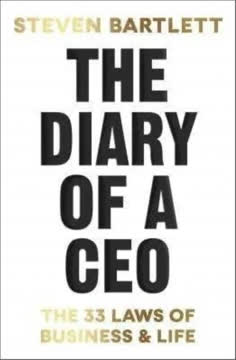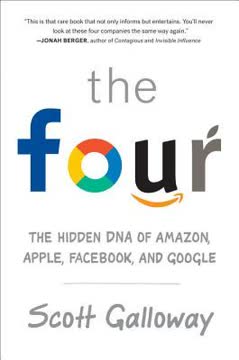Key Takeaways
1. Leadership is about inspiring change and delivering results through others
"Leadership is more than management. It's about inspiring change and improving results through who you are and how you motivate others."
Effective leadership requires a combination of strategy, execution, talent management, and personal proficiency. Leaders must create a compelling vision, build organizational systems to deliver results, motivate and develop employees, and act with integrity. To build a strong leadership brand, focus on achieving specific results over the next 12 months, decide on key attributes you want to be known for, and create a leadership brand statement that aligns with stakeholder values.
Employee engagement is crucial for leadership success. Move employees from disengagement to engagement by providing:
- Autonomy: Freedom to be creative
- Mastery: Opportunity to excel at their work
- Purpose: Understanding the meaning behind their efforts
Remember, changing the context of where people work can significantly impact their behavior and the overall organizational culture.
2. Financial statements are the language of business success
"Accounting is the language of business. Unless you are keeping track of how your company is doing, you won't know how to improve it."
Three key financial statements form the foundation of business understanding:
- Balance Sheet: A snapshot of assets, liabilities, and equity at a specific point in time
- Income Statement: Shows revenue, expenses, and profitability over a period
- Statement of Cash Flows: Tracks cash movement through operating, investing, and financing activities
Financial ratios provide insights into a company's performance:
- Debt-to-equity: Measures financial leverage
- Current Ratio: Indicates liquidity and ability to pay short-term obligations
- Return on Equity: Shows profit generated from shareholder investments
- Net Profit Margin: Reflects efficiency in cost control and revenue conversion
Understanding these statements and ratios allows business leaders to make informed decisions, identify areas for improvement, and communicate effectively with stakeholders.
3. Entrepreneurship thrives on solving pain points and experimenting
"Entrepreneurial Management is about solving unknown problems (pain) with unknown solutions (innovation). The key to solving uncertainty is by identifying pain, and the key to finding the right solution is by experimentation."
Opportunity identification is crucial for entrepreneurial success. Look for sources of opportunities such as:
- Unexpected successes or failures
- Incongruities between what is and what should be
- Process gaps
- Demographic changes
- Changes in perceptions and mood
Validate ideas through a feasibility study, considering both internal and external factors:
- Internal: Unfilled customer needs, intellectual property rights, first-mover advantage
- External: Existing competition, market size potential, substitute products, regulatory changes
Use quantitative and qualitative screening to assess the viability of new ventures. Focus on market size, profitability potential, speed to harvest, and team capability. Conduct interviews with the management team to gauge their vision, knowledge, and plans for the future.
4. Strategic thinking balances competitive edge with customer value
"You can differentiate any product or company, even commodities."
Competitive strategy involves finding ways to stand out in the market:
- Perform activities differently and better than competitors
- Perform different activities altogether
To create a lasting competitive advantage:
- Recognize things as they really are, not as they ought to be
- Adapt to changing circumstances or change the environment
- Create a strategic advantage through connected activities that support core differentiating value
Value proposition should focus on solving customer pain points or enhancing their experience. Use the VRIO framework to assess your competitive advantage:
- Valuable
- Rare
- Costly to Imitate
- Organized to capture value
Remember, strategy is only as good as its implementation. Continuously analyze your competitive landscape and adapt your approach accordingly.
5. Creativity and innovation stem from associative thinking and experimentation
"Creativity is an evolutionary process. Starting with the vision (on day 1), ideas are tested, tweaked, and tested again."
Foster creativity by changing your habits and patterns of work. Creativity is about:
- Breaking the status quo
- Engaging in associative thinking
- Generating new ideas
Use various techniques to enhance creative thinking:
- Mindmapping for non-linear connections
- Brainstorming (properly executed)
- Six Thinking Hats method
Innovation process:
- Start with abstraction: Define the story and purpose
- Create the experience in your mind's eye
- Conduct a feasibility study
- Develop the physical solution
Remember Clayton Christensen's "Job to Be Done" theory: Focus on understanding why customers "hire" your product or service, not just what they buy.
6. Effective decision-making requires a structured approach and diverse perspectives
"Decisions affect your life and happen on a daily basis. Learn how to make the best ones possible in order to achieve stellar results."
Use a structured approach for decision-making:
- Define the problem correctly
- List all objectives
- Brainstorm alternatives
- Evaluate consequences
- Consider trade-offs
Be aware of common decision traps:
- Rushing to solve the wrong problem
- Absence of a simple, powerful, shared judgment process model
- Failing to specify, articulate, and evaluate the decision trigger
Leverage diverse perspectives by:
- Seeing situations from multiple angles (framing)
- Encouraging team input and discussion
- Being aware of cognitive biases such as availability heuristic, representativeness heuristic, and overconfidence
Remember, practice makes permanent. Continuously refine your decision-making skills through intentional practice and reflection.
7. Global management demands cultural awareness and adaptability
"It's not just geography that causes distance."
CAGE Distance Framework helps navigate potential pitfalls in international strategy:
- Cultural Differences: Languages, ethnicities, religions, values, norms
- Administrative Differences: Political landscape, legal systems, currencies
- Geographic Differences: Physical distance, time zones, climates
- Economic Differences: Wealth disparities, infrastructure, natural/financial resources
Successful global expansion requires:
- Understanding local needs and cultures
- Adapting products and strategies to meet market-specific requirements
- Recognizing that distance is created by more than just geography
Before entering new markets, conduct thorough research on cultural attitudes, behaviors, expectations, and values to increase your chances of success.
8. Performance management aligns individual goals with organizational objectives
"If there is a motivation problem, there could be a control problem."
Effective performance management involves:
- Setting clear business goals
- Assigning decision rights
- Establishing performance measures
- Creating incentive systems
Use a Balanced Scorecard approach to measure performance across multiple dimensions:
- Financial perspective
- Customer perspective
- Internal processes perspective
- Learning and growth perspective
Avoid common pitfalls:
- Surrogation: When the measure itself becomes the end goal
- Misaligned incentives: Ensure individual rewards align with organizational objectives
Remember, what gets measured gets done. Regularly review and adjust your performance management system to ensure it continues to drive desired behaviors and outcomes.
9. Change management is a delicate balance of emotion and logic
"Change is emotional. Find ways to nudge change in the right direction."
Successful change management involves three key stages:
- Unfreezing: Ending the past and creating openness to change
- Changing: Navigating the neutral zone between old and new
- Refreezing: Settling into the new normal
To motivate people through change:
- Help them see and feel the need for change
- Address emotional resistance
- Provide a clear purpose, picture, plan, and role for individuals
Implement change strategically:
- Build a coalition of supporters
- Communicate effectively and frequently
- Time and sequence changes carefully
- Maintain credibility throughout the process
Remember, people need to go through all stages of change simultaneously. Support them by acknowledging the difficulties and emphasizing the benefits of the new direction.
10. Ethical leadership builds long-term success and personal fulfillment
"Business ethics is more than just keeping you out of jail. Living ethically leads to a more fulfilling life, enabling you to leave a legacy you can be proud of."
Ethical decision-making process:
- Stop and think
- Gather facts
- Brainstorm solutions
- Decide
- Evaluate the decision against ethical standards
When facing ethical dilemmas, ask yourself:
- Would I be comfortable if this decision ended up on the news?
- Does this decision align with my long-term goals and values?
- How will this impact stakeholders and my reputation?
Cultivate ethical leadership by:
- Moving from short-term to long-term thinking
- Considering the broader impact of decisions
- Fostering a culture of transparency and integrity
Remember, ethical behavior is not just about following rules but about building trust, credibility, and leaving a positive legacy in business and life.
Last updated:
FAQ
What's "The Visual MBA" about?
- Comprehensive Overview: "The Visual MBA" by Jason Barron is a visual guide that condenses two years of business school into a single, illustrated book. It covers essential MBA concepts in an engaging and accessible format.
- Sketchnotes Format: The book uses sketchnotes, a method of visual note-taking, to present complex business ideas in a simplified and memorable way.
- Wide Range of Topics: It includes topics such as leadership, finance, marketing, operations management, and entrepreneurship, providing a broad overview of what is typically taught in an MBA program.
- Practical Application: The book is designed for those who want to understand MBA concepts quickly and apply them in real-world scenarios without the need for extensive reading.
Why should I read "The Visual MBA"?
- Time-Efficient Learning: The book offers a quick and efficient way to grasp key MBA concepts without spending years in business school.
- Visual Learners: It is particularly beneficial for visual learners who prefer diagrams and illustrations over text-heavy content.
- Cost-Effective: It provides the core knowledge of an MBA program at a fraction of the cost, making it accessible to a wider audience.
- Engaging Content: The sketchnotes format makes learning fun and engaging, which can enhance retention and understanding.
What are the key takeaways of "The Visual MBA"?
- Leadership and Strategy: Understanding the importance of leadership in inspiring change and strategic planning for long-term success.
- Financial Acumen: Gaining insights into financial reporting, managerial accounting, and the importance of financial ratios.
- Marketing and Operations: Learning about market segmentation, positioning, and the essentials of operations management.
- Entrepreneurial Mindset: Emphasizing the need for creativity, innovation, and strategic thinking in entrepreneurial ventures.
How does Jason Barron use sketchnotes in "The Visual MBA"?
- Visual Summaries: Sketchnotes are used to summarize complex lectures and concepts into simple, visual representations.
- Engagement and Retention: The visual format helps in engaging the reader and improving retention of the material.
- Simplification of Concepts: By distilling complex ideas into visual notes, the book makes it easier for readers to understand and recall information.
- Creative Learning: The use of sketchnotes encourages a creative approach to learning, making it more enjoyable and less daunting.
What is the "Leadership Brand" concept in "The Visual MBA"?
- Personal Branding: The concept involves creating a personal leadership brand that reflects how you want to be perceived by others.
- Steps to Build a Brand: It includes steps like identifying desired results, defining personal descriptors, and creating a leadership brand statement.
- Alignment and Delivery: Emphasizes the importance of aligning your behavior with your brand and consistently delivering on your brand promise.
- Impact on Leadership: A strong leadership brand can inspire trust and motivate others, enhancing your effectiveness as a leader.
How does "The Visual MBA" explain financial statements?
- Balance Sheet Basics: The book explains the balance sheet as a snapshot of a company's financial position, detailing assets, liabilities, and equity.
- Income Statement Insights: It covers the income statement, also known as the profit and loss statement, which shows revenue, expenses, and net profit.
- Cash Flow Importance: The cash flow statement is highlighted as a critical tool for understanding the inflow and outflow of cash in a business.
- Financial Ratios: The book discusses the use of financial ratios to assess a company's performance and financial health over time.
What is the "Competitive Angle" in "The Visual MBA"?
- Unique Selling Proposition: The competitive angle refers to the unique aspects of a product or service that make it stand out in the market.
- Solving Pain Points: It involves identifying and addressing specific pain points or needs of the target audience.
- Creating Distinction: The angle should create a distinct and memorable impression that differentiates the product from competitors.
- Emotional Connection: Building a personal connection with customers through the competitive angle can enhance brand loyalty and engagement.
What are the best quotes from "The Visual MBA" and what do they mean?
- "A picture is worth 1,000 words." This quote emphasizes the power of visual learning and how sketchnotes can effectively convey complex ideas.
- "Manage your energy, not your time." It highlights the importance of focusing on energy management for productivity rather than just time management.
- "Simplicity is the ultimate sophistication." This quote, attributed to Steve Jobs, underscores the value of simplifying complex problems to find elegant solutions.
- "Success is going from failure to failure without loss of enthusiasm." A quote from Winston Churchill, it encourages resilience and perseverance in the face of challenges.
How does "The Visual MBA" address entrepreneurial management?
- Problem-Solving Focus: The book emphasizes solving unknown problems with innovative solutions through experimentation and iteration.
- Desirability, Feasibility, Viability: It stresses the importance of ensuring that a business idea is desirable, feasible, and viable before pursuing it.
- Revenue Models: Mapping out revenue models to identify key activities and customers is crucial for maximizing profitability.
- Pricing Strategies: The book discusses the significance of pricing strategies and how to determine the right price through customer surveys.
What is the "Job to Be Done" theory in "The Visual MBA"?
- Customer-Centric Approach: The theory focuses on understanding the specific job or task that customers hire a product to do.
- Real-World Example: The book uses the example of a fast-food chain improving milkshake sales by identifying the job customers wanted the milkshake to perform.
- Sales Impact: By aligning the product with the customer's job to be done, the company was able to significantly increase sales.
- Innovation Insight: This approach encourages businesses to innovate by focusing on the underlying needs and motivations of their customers.
How does "The Visual MBA" explain strategic thinking?
- Historical Lessons: The book draws lessons from historical leaders to illustrate the importance of strategic thinking and adaptability.
- Clear Communication: Emphasizes the need for clear communication of vision and strategy to ensure alignment and understanding among team members.
- Adapting to Change: Highlights the importance of adapting strategies to changing circumstances and environments for sustained success.
- Leadership Traits: Discusses key leadership traits such as responsibility, authority, and the ability to inspire and motivate others.
What is the "Balanced Scorecard" in "The Visual MBA"?
- Performance Measurement: The balanced scorecard is a tool for measuring organizational performance across multiple perspectives, including financial, customer, and internal processes.
- Objective Alignment: It helps align business activities with the organization's vision and strategy by setting specific, measurable objectives.
- Comprehensive View: Provides a comprehensive view of performance by incorporating both financial and non-financial measures.
- Strategic Management: The balanced scorecard is used as a strategic management tool to monitor progress and drive continuous improvement.
Review Summary
The Visual MBA receives mixed reviews, with ratings ranging from 1 to 5 stars. Many readers appreciate its concise visual approach and find it useful as a quick reference or introduction to MBA concepts. However, critics argue it lacks depth and may not be suitable for beginners. Some praise its accessibility and engaging format, while others feel it oversimplifies complex topics. The book is generally seen as a helpful overview or refresher but not a substitute for a full MBA program or in-depth business education.
Similar Books










Download PDF
Download EPUB
.epub digital book format is ideal for reading ebooks on phones, tablets, and e-readers.




